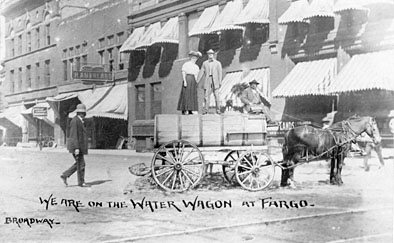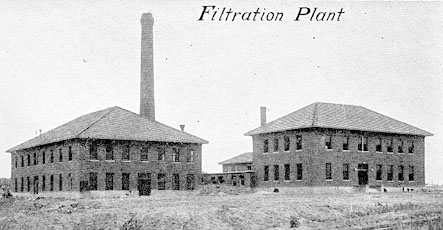Water Treatment

There were a few shallow wells dug by hand in the Fargo's early days and a few drilled artesian wells. Some people collected rainwater in cisterns. Fargo's underground water supply was too shallow for many wells, however, so the Red River was the primary source for water. Residents stored river water in barrels, so they would have it for drinking, bathing, washing clothes, and watering livestock. Later, vendors using horse-drawn water tanks sold river water house-to-house.
The 1909 postcard to the right shows a Fargo water wagon. Note that the wagon and horses are superimposed on the background street scene.
In 1880, the Fargo Water and Steam Company (a privately-owned firm) built a pumping station and a small dam in Island Park. The system delivered raw, untreated river water though its water mains. People became increasingly concerned about public health. With all the cities and farms springing up, the Red River was becoming heavily polluted with sewage and waste and residents became concerned about such diseases as cholera, typhoid fever, dysentery and diphtheria. So, with the river water in Fargo increasingly unsafe for drinking, too hard for washing clothes and almost useless in boilers because it corroded them, it was time for a change.
In 1887, the legislature of Dakota Territory took the first steps toward remedying our water problems. So did the Fargo Board of Trade, by crafting a law authorizing municipal waterworks and fire fighting systems - with taxing power to pay for it all. Change, however, was slow to come. In 1910. Fargo attorney V.R. Lovell was elected mayor on a platform that included an ambitious program of public works. Once in office, Lovell and his supporters laid plans to build a water treatment plant, and in July 1910, The citizens of Fargo approved a $65,000 bond issue to finance the plant. It was city engineer Frank Anders who was to play a pivotal role in bringing clean water to Fargo.
C. Arthur Brown, a Chicago engineer, became an important collaborator with Anders advising and approving all plans. Because Brown was still working as a water engineer for American Wire and Steel, their discussions were often held in secret. Meeting in a southern hotel, the two men finally settled on the New Orleans water works as a model comparable to the situation in Fargo. Architecturally, Anders' design proposal reflected the early 20th-century City Beautiful movement, whose classical elements promoted progress, science and technology.
Location was another issue. Anders proposed the old Island Park site for the plant, but the city wanted to build further south at a spot that, at that time was still outside the city limits. Luckily for all of us, Anders drafted a new set of plans and specifications, which were approved by the city council and let for bids in May 1911. Local builder James Kennedy received the official nod as chief contractor for the city's first pumping station and filter plant. Again, a squabble took place. Kennedy's low bid of $98,960 was challenged, but he won out when the courts finally ruled in his favor. Fargo broke ground for the first water treatment plant on June 15, 1911. By December, the walls and smokestack were up " and you had better believe it is a striking feature on our landscape" wrote Anders to Brown. In June 1913, the Fargo waterworks began pumping treated water into the city's water mains. - "It was" - said Anders when it opened, "the most important municipal improvement that the city has yet undertaken."
In 1911-1912 the City of Fargo planned and built one of the nation's earliest municipal water softening and filtration plants to treat water pumped from the Red River of the North. The plant's genesis was marked by controversy, partly the result of city politics, but also from the rapidly changing technology of drinking water purification. The facility was designed by Fargo City Engineer, Frank L. Anders, in collaboration with C. Arthur Brown and others, the probably represented the most important municipal improvement the city had undertaken up to that time. Although the construction came in over budget and was completed somewhat later than planned, the pumps, filters, controls, and mains worked more or less as designed.

The historic Fargo Water Treatment Plant occupied a tract bounded by the Red River, Thirteenth Ave. South, Fifth Street South, and Fourteenth Avenue South. Originally build in rural surroundings on the outskirts of town, by the late twentieth century it became part of an extensive residential neighborhood. The facility resembled a picturesque park with its massive, tile-roofed buildings and manicured lawn dotted with shade trees. The plant was a complex of buildings and structures, the most prominent of which was the Filter House and the Pump House. The main buildings were well-disciplined examples of City Beautiful Classicism. Over the years the plant saw other buildings added to meet the needs of the city of Fargo and its growing population.
The photograph above is from a 1912 Fargo brochure. The postcard below shows the Red River on the right and the water treatment plant on the left.

In 1972 the plant was modernized and increased its capacity from twelve million gallons a day to thirty-seven million gallons a day.
A 1989 study recommended increasing Fargo's water treatment capacity by replacing the old plant with a new water treatment plant. In 1992 Fargo proposed to construct a new water treatment plant with a capability in excess of thirty million gallons per day, at a site adjacent to the upon the old plant complex. The project was approved and received partial federal funding. To avoid rebuilding that system, the new plant was built immediately adjacent to the old plant. As the initial step in construction, the city of Fargo purchased 31 homes located on the new plant site. Construction began in 1994. Bob Welton, city engineer for utilities for the City of Fargo, was been involved in the new water plant project since its early planning stages in 1989. Fargo's new water treatment plant was designed by Black & Veatch of Kansas City and Ulteig Engineers of Fargo. The new water plant, built at a cost of over 42 million dollars with a capacity of thirty million gallons a day, easily expandable to handle forty-five millions gallons per day.
The new plant was completed in 1997 and the old plant buildings were demolished in 1998.
